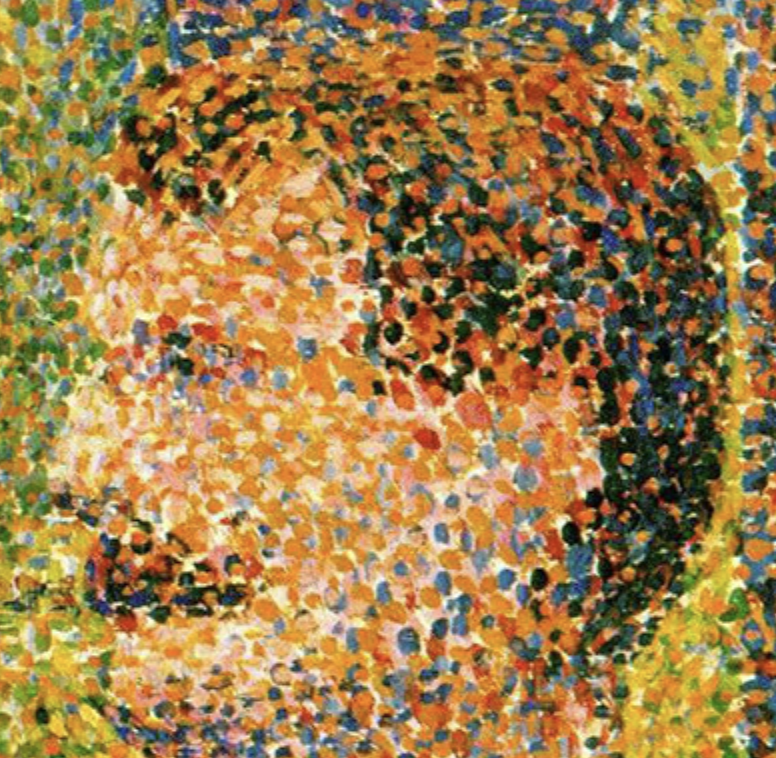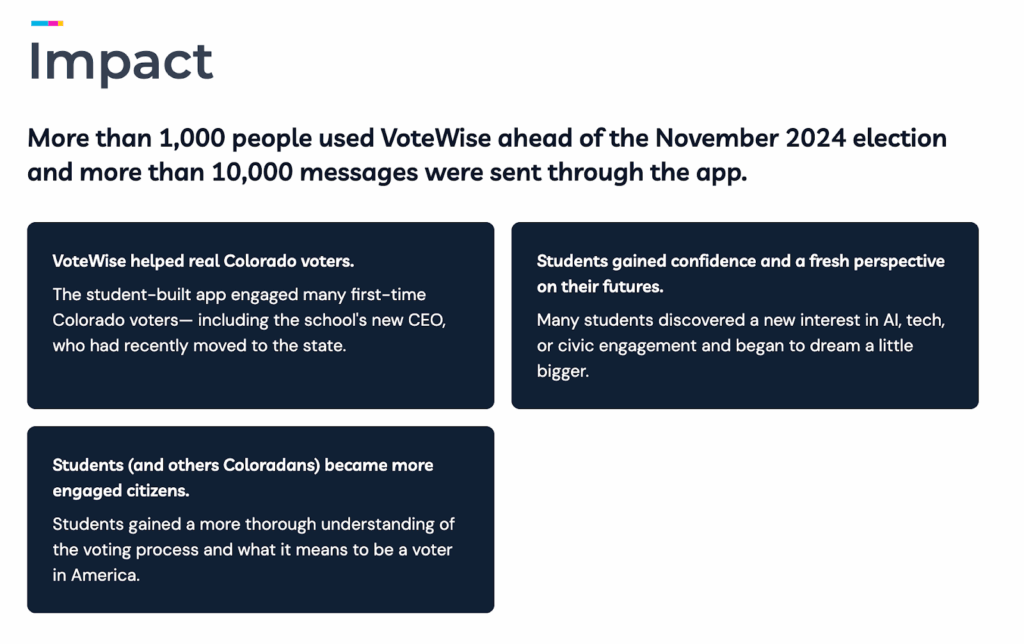AI is overriding education. This technology boasts massive opportunity, allowing for powerful learning experiences (experiential and project-based) to be ungraded while still showcasing rigor, growth and capability, along with an infinite capacity for processing large swaths of data. At the same time, it also brings a suite of challenges—small stuff, like changing the value proposition of and approach to “school” as we know it.
As a result, setting learners up for success means supporting them in collecting, articulating and curating their lived experience as data because in an AI world, evidence and data are king, queen, and court jester. This requires a fundamental shift in self-knowledge, how learning is measured and communicated, and both the role of educators and networks. In the wake of AI, schools will need to create cultures of documentation, reflection and visible learning; students will need to develop storytelling capacity for identifying, articulating and sharing their own stories; and educators will need to become co-authors of the learners’ story to date and their story to come, as well as being a conduit to the outside world.
“For the master’s tools will never dismantle the master’s house. They may allow us to temporarily beat him at his own game, but they will never enable us to bring about genuine change.”
—Audre Lorde
If we want to transform education, truly shift power to learners, we can’t just automate outdated systems or digitize standardized pathways. Audre Lorde reminds us that the tools of the old system will never bring about the deep, structural change our learners need. To do that work, the real work, we must build new tools—ones that center student agency, that honor identity and process, and that invite learners to document, reflect on, and share their own journeys.
In the age of AI, the technologies that matter most don’t just deliver information—they help learners capture and narrate who they are becoming. They make learning visible, mobile, and personally owned. They override traditional modes of assessment and pedagogy. The most promising edtech today helps students move from Passive to Active, from Consumer to Creator, from Thinker to Doer. These platforms don’t ask learners to adapt to a system; they ask the system to adapt to the learner. Thus making the collection and curation of evidence easier and more joyful. In this new age, learners will need to contemplate the various metaskills that they are gaining through their work, and they will have to be able to use experiences, reflections and evidence to individuate and tell their own unique story. Over time, this practice creates a textured record of what a learner knows and is able to do. Rather than a sketch, it creates a collage. Rather than using a stroke of paint, the learner becomes a pointillist portrait.

The right tools help learners recognize moments of learning as they happen, name the skills being developed, and reflect on how these moments shape their evolving story. They act as both mirrors and amplifiers:
- Mirrors help students see themselves more clearly, calling attention to moments of growth they might otherwise miss.
- Amplifiers legitimize the learner’s story in ways that can be shared beyond the classroom—with peers, educators, families, communities, and future employers.
Technologies that do both help to create a textured view of both learning and the learner.
Technologies That Create a Textured View
Rather than being built for compliance or content delivery, learner-centered, AI-powered tools must be designed around four principles:
- Documentation capturing evidence of process, not just final product.
- Reflection scaffolding prompts and opportunities for students to interpret their own growth.
- Communication giving learners channels to share stories with authentic audiences.
- Portability providing learners with a tool that is not only interoperable with the school’s data, but with the world.
When experiences are rich and technologies are aligned, learners don’t just collect data about their education—they craft a narrative. They learn to see, to name, and to share who they are becoming. While still uncommon, there are some technologies that are built with these principles in mind, already communicating powerful stories of their own.
CommunityShare fosters a direct relationship between learners and their community, telling the story of collaboration through rich data. It connects classrooms to local mentors, creatives, entrepreneurs, scientists, and culture-bearers—allowing students to engage in authentic, place-based projects that reflect real-world relevance. Instead of passively absorbing knowledge, students co-create with community members, engaging in work that matters beyond the classroom walls. This tool bridges academic goals with lived experience, empowering students to see themselves as contributors to their communities—creators of impact, not just consumers of curriculum. It invites students to explore who they are in context, grounded in culture and purpose.
Example: CommunityShare, alongside the Sunnyside Unified School District and Foundation, the Pima County Superintendent’s Office, University of Arizona faculty and students, and the University of Arizona Udall Center, recently completed a GIS and mentorship project. It involved:
- Multi-generational mentoring: College students mentored high schoolers, who in turn mentored middle schoolers.
- Community partnerships: Local government officials, STEM professionals, and nonprofit leaders were actively involved throughout the program.
- Real-world learning: Students used Geographic Information Systems (GIS) to investigate and compare local parks, gathering data, analyzing results, and creating interactive digital StoryMaps to share their findings.
Middle school students received foundational training in GIS, learned data collection and visualization skills, and tackled driving questions about equity and access in their neighborhoods. Their projects weren’t hypothetical—they were rooted in their own lived experiences and were shared with city leaders who could take action.
Unrulr is a digital portfolio and learning ecosystem that reimagines how students document and reflect on their growth by turning everyday learning into shareable, evolving evidence. Instead of relying solely on traditional assessments, Unrulr enables students to capture their process—through video, voice, writing, and artifacts—allowing them to showcase not just what they’ve done, but how they’ve learned. It encourages iteration over perfection, storytelling over compliance. By placing ownership of documentation in the hands of students, Unrulr shifts them from passive receivers of feedback to active curators of their journeys. They learn how to show their thinking, not just their outcomes—and in doing so, they become authors of their own growth narrative. (See case study.)
Playlab uses AI to supercharge student imagination. Whether prototyping a game, building an interactive story, or testing an idea, Playlab gives learners intuitive tools to design, refine, and express their thinking. It transforms passive screen time into active creation. Importantly, Playlab doesn’t position AI as the teacher—it positions it as a collaborator. Students engage with technology as builders and explorers, not just users. In doing so, they practice experimentation, agency, and iterative learning—the skills that make thinkers into doers. (See case study.)
Example: Teacher Zach Kennelly’s senior Civics class aimed to make voting easier for their parents, ultimately improving the process for everyone in Colorado. Many of Zach’s students came from homes where English was a second language, and their family members often felt overwhelmed by the voting process and the state’s extensive 122-page voting guide. The students decided to develop an app that would offer clear and practical assistance for voting.

LearnCard gives students a secure, learner-owned digital wallet for their achievements. Built on decentralized principles, LearnCard allows learners to collect, carry, and share credentials across platforms, organizations, and borders. Learning doesn’t stay locked in an LMS or confined to a classroom—it becomes a portable, living asset that evolves alongside the learner. Students become stewards of their own record, controlling how their experiences are recognized and represented. It transforms credentialing from a top-down declaration into a bottom-up demonstration—rooted in self-authorship and real-world utility.
Example: At the recent Digital Badges Summit, Jonny Coreson at Learning Economy Foundation shared about the Brag Book, a staple in the military for documenting moments where you did a good job. This resource was later used to bolster your credentials for promotions, mobility, etc. LearnCard is working with Jonny to develop VetPass, enabling veterans to collect and manage verified digital credentials, inform programs and services of their desired path, explore roles in high demand, close skill gaps to meet role requirements, and connect directly to open career opportunities. VetPass is the personalized user experience on which veterans will encounter all those programs and services that exist to support them.
Hope and the Horizon
While these technologies are works in progress, they are harbingers of a new paradigm. They are built on the principle that learning must be more human rather than less. They don’t reinforce old hierarchies; they build new narratives. They treat learners not as endpoints in a system, but as evolving, reflective storytellers, capable of capturing their growth, claiming their progress, and contributing to the world around them. They are not the master’s tools. They are something altogether different—built not to preserve the house, but to imagine a better one.
Do I contradict myself?
Very well then I contradict myself,
(I am large, I contain multitudes.)Walt Whitman from, Song of Myself
The post A Textured View: How Stories Are The Currency of Badging appeared first on Getting Smart.